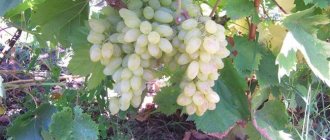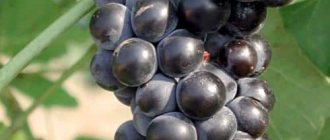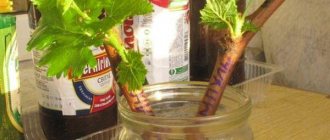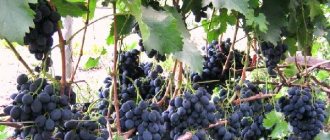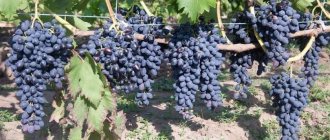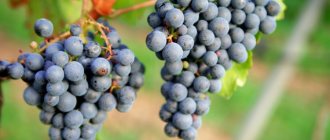History of variety selection
The authorship of the variety belongs to Novocherkassk VNIIViV named after. ME AND. Potapenko. The selection material was vines of two varieties: the Hungarian “Zala Dendy” and “Magarach’s Gift”, selected by the Yalta VNIIViV “Magarach”.
An application for registration of a newly bred early grape variety called Platovsky was submitted by employees of the Novocherkassk All-Russian Research Institute of Viticulture named after. ME AND. Potapenko was submitted in 2002. In 2003, the variety was officially registered in the State Register of Breeding Achievements. The second name that can be found among manufacturers of planting material is “Early Dawn”.
Description of Platovsky grapes
Technical grapes for their primary purpose ripen in just 110-115 days. The growth of vines per year is average. The clusters on the bush are small in size, on average 200 g each. Their shape is mostly cylindrical-conical. A photo of Platovsky grapes shows that the clusters are not too large, like many other technical varieties.
Grapes are initially light green or even whitish in color. During the season they gain weight up to 2 g. The shape is round, with a thin, but strong and fairly tough skin. As they ripen, they acquire a slight pinkish tint. The taste is rated as pleasant, sweet and sour. The dry table wine obtained from Platov grapes has a tasting score of 8.4 points.
Juice pressed from fresh ripe Platovsky grapes contains up to 8.9 g of acid per 1 liter, sugar content is 20.2%. Of all the growing shoots, 85% are fruitful. On average, 1-2 clusters are formed on one shoot. After ripening, there is about a month to harvest the Platovsky grape bushes, during which the clusters remain dense and the berries do not fall off. The variety is zoned for the Crimea and the North Caucasus.
Comparison with similar varieties
It is quite difficult to compare technical varieties with each other, because each of them has its own advantages and disadvantages. The bunches of “Platovsky” are slightly lighter than those of “Zigerebe”, but heavier than “Magarach’s gift”. But it differs from its parents in the earliest period of ripening.
The taste characteristics are slightly inferior to the nutmeg varieties: “muscaris”, “Odessa nutmeg” and “ottonel”, however, “Platovsky” is favored by its high resistance to diseases and bad weather conditions.
The high sugar content of this grape is similar to such varieties as “Aladdin”, “King Ruby”, but is still inferior to “Biyanka”, “Solaris”.
Here is another comparison of “Platovsky” with other early technical varieties:
| Sign | Variety | |||
| Platovsky | Crystal | Bianca | Diana | |
| Ripening period | 110–115 days | 110 – 115 days | 110 – 120 days | 105 – 115 days |
| Frost resistance | -30C | -28C | – 28C | -30C |
| Productivity | Up to 300 c/ha | 160 – 200 c/ha | Up to 200 c/ha | 145 – 150 c/ha |
| Bunches | 200 g | 170 – 220 g | 90 – 120 g | 180 – 250 g |
| Taste | Pleasant with a slight sourness | Harmonious | Harmonious | Harmonious |
| Color | Pink | Yellow-green | Yellow-green | Dark pink |
| Disease resistance | High | High | Above average | Above average |
| Shelf life | 1 month | 1 month | 1 – 2 months | 1 – 2 months |
| Sugar accumulation | 20 – 21% | 17 – 18% | 20 – 28% | 17 – 21% |
| Acidity | 9 g/l | 6 – 7 g/l | 7 – 9 g/l | 6 – 9g/l |
Characteristics of the variety
In zoning areas, Platovsky is grown for further processing. But in private farms it is grown not only for wine and juice, but also for food. What gardeners especially appreciated is that the first harvest from a bush can be harvested already in the second year after planting the seedlings.
The description of the Platovsky grape variety indicates that in the first year after planting the vine grows quickly, without losing its growth rate in subsequent years. The flowering of the variety is bisexual. This is important to consider when planning planting grapes on the site. Platovsky is a pollinator for vines of other varieties.
Drought resistance, frost resistance
According to the description of the variety, it is able to withstand temperatures down to -29 °C in winter. In those regions for which it is zoned, the vine is used for landscaping terraces and gazebos, without being removed for shelter for the winter. If you plant the variety in a region where winters have little snow but are cold, then the bushes will need shelter.
In the autumn, when the Platovsky grapes shed their leaves, pruning is carried out. Then the bole is hilled and metal arcs are installed along which the agrofibre is stretched. To prevent the bushes from rotting, the entrance and exit to the “tunnels” are left open, closing at frosts below - 15 ° C. When snow falls, it is shoveled over the agrofibre.
Productivity and fruiting
On average, it takes 110 days for the brushes to mature, but much depends on weather conditions. The more sunny days there were during the season, the higher the quality of the harvest. If the berries have not had time to gain sweetness, they are left to ripen on the branches. They can continue to collect sugar for another month without falling off the bushes.
According to reviews, gardeners in the Moscow region harvest an average of up to 6 kg of berries per bush from Platovsky grapes. Their taste is pleasant, and their thick skin is not damaged during transportation. The yield is affected by the weather during flowering, since the presence of pollinators is important, as well as additional mineral fertilizing. In cloudy weather, keeping ripened berries on the bushes for a long time will not help; they will still remain sour.
Area of application of fruits
Thick brushes are great for storage and transportation. Since the taste of Platovsky grapes is assessed as very pleasant, its berries can often be found on sale next to table varieties in growing areas and beyond.
And yet the main purpose is technical. Most of the berry harvest is sent for processing to wine and vodka factories, where it is used to produce dry white and semi-sweet wine. The juice is suitable for canning; it is also pressed for subsequent sale in various containers.
Resistance to diseases and pests
According to the assessment of breeders who were testing a new variety at VNIIViV named after. ME AND. Potapenko, the resistance of Platovsky grapes to the following diseases is assessed:
- Mildew – 2 points;
- Oidium – 2.5 points;
- Phylloxera – 3 points;
- Gray rot – 2 points;
- Downy mildew – 2 points.
This means that even with severe damage to the leaves by diseases and insect pests, the Platovsky grape bush is capable of producing a harvest of berries. At the same time, the vine gratefully responds to preventive measures and timely treatment against diseases common in the area.
Advantages and disadvantages of the variety
Among the most important advantages of the Platovsky variety, the following were noted:
- Unpretentiousness to soil composition, rooting of seedlings on fertile and poor soils tends to 100%.
- It propagates easily, and it is recommended to use the “Cober 5BB” variety as a rootstock.
- Even after a short sanitary pruning, the bush produces a good harvest of berries next year.
- Under unfavorable weather conditions, slightly fewer berries are set than in sunny weather, but the amount of sugar in them will be reduced.
- Harvest time: 1 month after ripening.
- Platovsky grape berries can be consumed fresh, processed into wine and juice, and also dried.
- Due to the high sugar content, it is possible to obtain wine of excellent quality and strength.
Among the disadvantages of the variety, the need for shelter in regions where winters are cold and with little snow is noted.
Reviews
We have collected the most important comments for you to help you choose the right variety.
“I bought this variety years ago and I don’t regret it at all: it ripens earlier than others, has a sweet taste, good yield, high frost resistance. I usually leave 2 bunches on the shoots, and I also pick off those leaves that prevent the berries from fully ripening.” Eugene
“We bought a house and found several grape bushes on the plot. It was determined that this is the Platovsky variety. It bears fruit well: you can eat it fresh, squeeze out the juice, and ferment the wine. The early ripening time is also pleasing.” Natalia
“I purchased Platovsky grapes in a specialized store. The very next year after planting, the bush bore fruit. The taste of the berries is not exotic, but quite pleasant.” Daria
“Platovsky has been making me happy for ten years now. Its yield stability, high disease resistance and minimal care efforts make me recommend this variety to all my friends. Another plus is the ability to survive the cold winter without shelter.” Sergey
By planting Platovsky grapes on his plot, the summer resident will ensure a stable decent harvest, a minimum of hassle, and an early treat with a pleasant-tasting berry dessert.
How to plant Platovsky grapes
Since the Platovsky variety is a technical variety, it is used for cultivation in private vineyards, as well as in industrial ones, where the care and collection of berries is carried out using mechanization. The variety responds gratefully to care, producing a stable harvest.
Recommended timing
Platovsky grape variety can be planted in both spring and autumn. Autumn planting is most often used. The first ten days of October are ideal. Even 10 days before a stable cold snap is enough for seedlings to take root in a new place. If the cold weather lingers, then by winter the bushes will have time to grow enough roots to survive the upcoming frosts. In spring, young bushes are planted when the soil warms up above + 12 °C.
Choosing a suitable location
Since all grape varieties, including Platovsky, are light-loving, areas for planting bushes are chosen so that the light falls on the rows from the south, west or southwest. It is not recommended to plant close to fences or building walls, as this significantly impairs the lighting of bushes that are not too tall. A distance of at least 5 m should be maintained from nearby fruit trees.
Low-lying areas, where moisture easily accumulates after rains, as well as in the spring after snow melts, are not suitable for grapes. Despite all its moisture-loving nature, Platovsky does not tolerate stagnation of water at the roots. If the plot is located on a slope, then it is best to allocate its middle part for the vineyard.
Selection and preparation of planting material
Most of the planting material of this variety is annual seedlings, the height of which is approximately 50 cm. A high-quality seedling has a thickness of about 1.5 cm. The roots are about 10 cm long. Sellers usually display Platovsky grapes in containers with a damp mash of earth and clay, so that the roots do not dry out. You should pay attention to the condition of your kidneys. They should be strong and barely burst in the spring. Nothing will grow from a seedling with dry or broken buds.
Landing algorithm
2-3 weeks before the expected planting date of the Platovsky variety, they begin to prepare planting holes or trenches. They do this in the following sequence:
- Mark places for holes. The gap between individual bushes is 80 cm, the depth of holes and trenches is 60 cm.
- A layer of small crushed stone or pebbles or expanded clay 10 cm thick is poured onto the bottom.
- Supports are installed in the center of the holes or trenches, to which seedlings are tied after backfilling. Tops of 15-20 cm in height should remain above the ground.
- For each hole or under each seedling, add a bucket of compost, to which add a glass of nitrophoska and wood ash.
Planting of Platovsky grapes is carried out in accordance with the accepted markings. The seedlings are lowered into the holes, carefully straightening the roots. Backfilling is carried out so that the eyes are above the ground (3-4 buds). Watering is carried out immediately so that the soil in the hole settles as densely as possible, and more is added if necessary.
When planting in autumn, in order to speed up the process of establishment of seedlings of the Platovsky variety, the ground under them is covered with film. Due to this, the soil around the bushes does not dry out too quickly.
How do the grapes in question differ from table varieties?
“Platovsky” grapes (the description of the variety is provided above), despite the fact that the size of its clusters and berries are not particularly large, can be placed on the festive table without shame. Its taste is absolutely in no way inferior to table grape varieties. “Platovsky” does not require special care.
The only drawback: if the grapes are intended to make a very large amount of wine, then you will have to plant more bushes than in the case of table varieties. And all because of the small size of the berries and clusters.
Thanks to its fairly elastic skin and dense pulp, the grapes are easy to transport.
Aftercare for grapes
The process of caring for Platovsky grapes does not differ significantly from the standard one required by most technical varieties. Fertilizing and watering, especially in the first years, can significantly increase productivity. To avoid mass damage by diseases and insects, preventive treatments with insecticides and fungicides are carried out in the spring. In autumn it is necessary to prune.
During the first month after planting, seedlings of the Platovsky variety are watered daily, consumption is about 5 liters per bush. In the future, it is enough to water once every 2 weeks. If we are talking about adult bushes, then they will need abundant watering only a few times per season:
- In the spring, as soon as the coverings are removed from the bushes.
- A week before flowering.
- Immediately after flowering and berry formation.
The optimal water consumption when watering Platovsky grapes is 5 liters for each plant. Wood ash is added to the water. The rule works: it is better to water less often, but abundantly, than often, but a little at a time. Water is released along the ground, preventing it from getting on leaves, berries and stems. A drip irrigation system made from perforated pipes or hoses dug into the ground is ideal. In some cases, watering is carried out along grooves that are dug at a distance of 30 cm from the bushes to a depth of 25 cm.
When the berries begin to ripen, stop watering the Platovsky grapes, as it can cause them to crack. In the fall, 10 days before the first cold weather, the last moisture supply is carried out, which should help the grapes prepare for winter.
If all the necessary fertilizers have been added to the planting hole, then the next feeding of this variety will be required only in the 3rd year of life. Then the plants are considered mature and begin to actively bear fruit. The preferred scheme for applying fertilizing to Platovsky variety bushes:
- In early spring with buds opening. Slurry is added with the addition of superphosphate and potassium salt. Instead of manure, urea or ammonium nitrate is used.
- When forcing brushes. Potassium and phosphorus fertilizers are scattered over the soil or added to irrigation water.
- When the first berries begin to ripen. In cloudy weather, they are sprayed with complex preparations: “Novofert”, “Aquarin”, “Kemir”.
To facilitate the process of caring for Platovsky grape vines and to avoid breaking off under the weight of ripening clusters and berries, the shoots are tied to supports. Usually, at the beginning and end of the row, pipes are installed vertically (if the row is long, then intermediate supports are also installed), to which wire is tied. Only such a support will support the heavy vine of this variety, strewn with berries. You can direct the shoots horizontally, vertically and in an arc.
Trimming
One bush of the Platovsky grape variety is capable of providing normal growth for 80 eyes. To do this, the shoots of last year are cut off, leaving 3-4 eyes on them after the fork. Stepchildren must be removed during the summer after the last cluster so that the bush does not waste energy on them. If the clusters are too heavily covered with foliage, then they are cut through, allowing the berries access to the sun.
Pruning is carried out in the fall, when all the foliage has been dropped. Spring pruning of grapes is not recommended, since it causes the vine to release juices. Platovsky’s yield suffers from this, and the bush may even die. In spring, only dried and frozen branches of bushes are pruned.
Protecting crops from birds and insects
The threat to the future harvest of Platovsky grapes is posed by attacks from birds, as well as bees and wasps. To protect against them use:
- Insecticides. However, it is important to understand that the poison will not be completely removed and will remain partially in the grapes.
- Net. This method is the most environmentally friendly and has no restrictions.
To protect Platovsky berries, in private vineyards, when there are only a few vines, they use netting to wrap each cluster. But for large areas this method is too labor-intensive. It is much easier to install additional supports and cover the entire planting of this variety and others with a net. It does not interfere with the passage of sunlight and air to the berries and foliage, but does not allow insects and birds to pass through. The net is installed when the crop begins to ripen.
Preparing the crop for winter
Procedures for preparing Platovsky grapes for winter begin with the first frost. By this time, most of the foliage from the bush should have already been dropped, and the mature vines have acquired their natural brown color.
The first is pruning, and all unripe remaining green vines are cut out. Then the grapes are catarrhized, cutting off the roots in the cervical part of the trunk to a depth of 20 cm. This treatment will eliminate the risk of freezing of the upper (dew) roots, giving the rest of the root system the opportunity to use all resources for growth.
If shelter is required in a given region, then Platovsky grapes are removed from the trellises and lowered to the ground, metal arcs are installed along the row and agrofibre is stretched. Its ends are closed only in frosts below 15 °C. The shelter from Platovsky should be removed in the spring when the buds awaken.
It is recommended to hill up the standard. This will increase the winter hardiness of the bush. To prevent damage to vines by rodents, it is important to remove fallen leaves, which serve as excellent building material for mouse nests. To rid Platovsky grapes of mice, baits, traps, and hard shelters (for example, slate) are used.
How to grow
"Platovsky" is very undemanding in care. The grapes produce small berries, the clusters are not large, so such an acute dependence on the overload of the bush, as happens in the corresponding varieties, is not observed here. The most important requirement remains excellent lighting.
- Watering - in fact, grapes only need abundant watering in the first 2 weeks. Then watering is carried out based on soil moisture and aridity of the region. The second important stage of watering is before covering the bushes for the winter. Before and during flowering, the plant does not need special watering. It will also be useful to learn about what to feed the grapes during flowering, and how to do it correctly.
- Pruning - on average there can be 50-60 eyes on a bush. 3-4 eyes are left on the main vine. All unnecessary buds and shoots are broken off to ensure sufficient sugar accumulation. For the same purpose, remove the leaves near the brush.
Grape pruning
- Mulching is a great way to retain moisture for a long time in a dry area. Mulch is poured 2 weeks after planting, and subsequently loosened.
Mulching grapes
- Processing – the variety is resistant to many diseases and pests, but not all. Treatment with fungicides is carried out according to the usual scheme and allows you to protect the plant from anthracosis, black spot, and so on.
The bush does not need special protection in winter, but if frosts in the region can be lower - -30 C, it is advisable to cover the bushes with spruce or straw.
- Alexander, Kaluga: “The grapes don’t look great. The berries are small, ordinary, the clusters are small, but from my point of view, they have excellent taste. In addition, “Platovsky” produces a large harvest.”
- Ekaterina, Rostov-on-Don: “Platovsky” is an option for those summer residents who come only on Saturday and Sunday. There is no need to water, there is no need to prune endlessly, there is no need to fight diseases. And the grapes, although not large, are tasty.”
- Stanislav, Belogorye: “I grow “Platovsky” and “Crystal” on the “Lydia” rootstock. I replaced them with varieties to get edible grapes that can survive frost. Very satisfied. The berry is not large, but for a technical variety this is not a drawback.”
- Boris, Kazan: “An excellent frost-resistant variety. Even in the worst summer, sugar levels rise. But, it’s true, not every grape survives in our conditions. I want to find a black one with the same characteristics as Platovsky.
“Platovsky” is settling in very well in its new location. Under favorable circumstances and good care, the first brushes appear the very next year after planting. However, the vineyard reaches full fruitfulness after 3 years.
The berries begin to actively ripen by early August. The clusters can remain on the bush for a long time: at the end of September, the shape and juiciness of the grapes remains the same as in mid-August.
The Platovsky variety is one of the most successful options for white wine grapes. However, its excellent taste made it popular not only among winemakers, but also among ordinary summer residents.
Methods of propagation of grapes
Ripe branches are excellent for propagating Platovsky grapes, which are recommended to be minted with the final formation of the bunches. The part of the branch that is located above the brushes is not beneficial for the ripening of the crop and can be cut off. Barked shoots with a thickness of 1.5 cm or more are suitable.
Cut branches from the Platovsky variety bush into pieces 35-50 cm long with 4-5 buds are stuck into pots with soil or buried in a free area until autumn. If by the first ten days several new leaves have formed on the seedling, then it can be safely transplanted to a new place.
For old bushes of this variety, you can use the method of digging in shoots. At a distance of 1.5 m from the trunk, bend a branch of the bush to the ground and dig it in to a depth of 60 cm, leaving the end with 3-4 buds outside. They do this in the spring. By autumn, if the outcome is favorable, the branch of Platovsky grapes will take root. Then the new bush is cut off from the mother one.
Features of planting and growing
Despite the unpretentiousness of the variety, Platovsky has peculiarities in planting and agricultural technology. Let's look at this in more detail.
Selecting a seat
The seat must meet the following requirements:
- A lighted, unshaded place with virgin soil or where pome and stone fruit plants were previously grown for 3 to 5 years.
- There should be no old vines at the proposed planting site, otherwise they will oppress the young plant.
- The depth of groundwater in the area should be from a meter to one and a half meters.
Important! If, for some reason, the area chosen for planting is periodically flooded
-
the construction of an embankment with a height of 0.5
-
1.2 m will be required.
Diseases and pests, methods of control and prevention
The most effective methods of controlling pests and diseases of the Platovsky grape variety are as follows:
- Avoid thickening of plantings. Air should circulate freely between the bushes. Damp, poorly ventilated foliage is an ideal environment for the development of fungal infections.
- All leaves, brushes, berries and shoots that are damaged and show signs of disease and/or pest damage must be immediately removed with pruning shears and burned.
- Before flowering, you can carry out preventive spraying with “Topaz”, a solution of Bordeaux mixture, “Kuproskat” to protect against fungi.
- Carry out regular inspections. If signs of such dangerous viral diseases as infectious chlorosis and rhesus mosaic are detected, immediately destroy the damaged plants, since there are no methods for combating diseases of this type.
Advantages and disadvantages of the variety
Platovsky grapes can easily replace ordinary table grapes. The advantages of this solution:
- it is easy to care for;
- ripens quickly;
- very tasty;
- has high frost resistance.
Reviews from gardeners about the Platovsky variety are mostly positive, but disadvantages are also mentioned. There are only two of them:
- some winegrowers detect the taste of nightshade in the berries;
- Dense bunches sometimes begin to rot.
Be that as it may, Platovsky grapes have collected many properties that are desirable in breeding and growing. It makes it possible to get southern fruits even in the northern regions, so it is more than worthy to take a place in any area.





